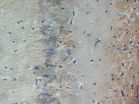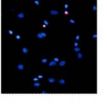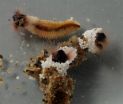(Press-News.org) Experts believe a molecule in parasitic worms could help explain why worm infections can effectively treat a range of autoimmune diseases, including multiple sclerosis, psoriasis, rheumatoid arthritis and lupus.
The Monash University study, published in the FASEB Journal, successfully identified peptides from parasitic worms that suppress the body's immune response. Researchers believe this could pave the way for a new drug containing the peptide to provide relief from the symptoms of autoimmune diseases.
Affecting as many as one in 20 Australians, autoimmune diseases occur when a person's immune system has an abnormal response against its own cells, tissues or even entire organs, resulting in inflammation and damage.
Lead researcher Professor Ray Norton from Monash Institute of Pharmaceutical Sciences (MIPS) said experts around the world have yet to fully understand the causes of autoimmune diseases, which have risen significantly in parts of the world.
"There are more than eighty autoimmune diseases, ranging in severity from mild to life threatening in some cases. While some affect mainly one area or organ, others can affect many parts of the body," he said.
"Many people believe there's a link between the rise in autoimmune diseases and an increased focus on cleanliness in western societies, because the immune system is no longer exposed to the broad range of infections that previous generations had to deal with.
"There could be some truth to this because worm infection is virtually unheard of in developed countries, yet the incidence of autoimmune diseases is high. But in developing countries the opposite is true," Professor Norton said
The new line of research offers an alternative to helminthic therapy, where people deliberately infect themselves with parasitic worms, in an attempt to put their autoimmune disease into remission. It's thought that the worms have a calming effect on their host's immune systems in order to ensure their survival.
Rather than using worms, the research team searched for the active components responsible for immunomodulatory effects in parasitic worms. By creating a cDNA library from the anterior secretory glands of the parasitic hookworm Ancylostoma caninium, they identified a peptide called AcK1 that dampens the immune system by inhibiting a potassium channel (Kv1.3).
Researchers found that AcK1 closely resembles ShK, a peptide from a sea anemone, which has been shown to suppress autoimmune diseases and is currently in clinical trials for the treatment of multiple sclerosis.
Dr Sandeep Chhabra from Monash Institute of Pharmaceutical Sciences, said the study will help in developing new drugs to treat autoimmune diseases.
"Our research shows that it is possible to identify individual molecules responsible for this beneficial affect," he said.
"The next step will be to see if we can develop this into a pill that could dampen the immune system in people with an autoimmune disease. That's a whole lot cleaner than putting a worm in your body," Dr Chhabra said.
INFORMATION:
'Worm pill' could ease autoimmune disease symptoms
2014-08-11
ELSE PRESS RELEASES FROM THIS DATE:
Autophagy is a new target for treatment of neuronal injury in the hippocampus of VD rats
2014-08-11
Autophagy is a basic catabolic mechanism by which unnecessary or dysfunctional cellular components are degraded by lysosomes. Damaged organelles such as mitochondria are scavenged by autophagic processes to maintain the stability of nerve cells. Excessive activation of autophagy leads to cell death. However, it remains unclear whether autophagy affects hippocampal neuronal injury in vascular dementia. Prof. Bin Liu and co-workers from the Affiliated Hospital of Hebei United University, China intraperitoneally injected wortmannin into a rat model of vascular dementia. They ...
Neuroprotective effects of Asiaticoside
2014-08-11
In the central nervous system, Asiaticoside has been shown to attenuate in vitro neuronal damage caused by exposure to β-amyloid. However, its potential neuroprotective properties in glutamate-induced excitotoxicity have not been fully studied. Researchers from Fourth Military Medical University of Chinese PLA, China reported that pretreatment with Asiaticoside decreased neuronal cell loss in a concentration-dependent manner and restored changes in expression of apoptotic-related proteins Bcl-2 and Bax. Asiaticoside pretreatment also attenuated the upregulation of ...
Selective verbal memory impairment due to left fornical crus injury after IVH
2014-08-11
The fornix, a part of the Papez circuit, transfers information of episodic memory between the medial temporal lobe and the medial diencephalon. It is difficult to precisely assess the fornix due to its long, thin appearance and its location within the brain. In addition, discrimination of the whole fornix from adjacent neural structure using conventional brain CT or MRI is impossible. By contrast, diffusion tensor tractography (DTT) has enabled three-dimensional visualization of the fornix, and many studies have reported on fornix injury using DTT. Dr. Sung Ho Jang and ...
New global research reveals significant shortfall in fruit and vegetable consumption
2014-08-11
New research published in the September issue of the British Journal of Nutrition highlights a significant shortfall in fruit and vegetable consumption in people's diets around the world. Commissioned by the Nutrilite Health Institute of Amway and conducted by Exponent, the research finds the majority of adults worldwide would have to at least double their current consumption of fruits and vegetables to meet the World Health Organization's minimum recommendation of five servings (400 grams) per day. Additionally, the vast majority of adults worldwide – 60 to 87% across ...
Study: new tool proves effective in evaluating doctor's bedside manner
2014-08-11
TORONTO, ON, Aug 11, 2014 —The best way to improve a doctor's bedside manner may lie in a new tool that evaluates and helps medical residents improve their communication and other soft skills to become better doctors, according to a new study led by Women's College Hospital's Dr. Tim Dwyer.
The study, published in the latest issue of the Canadian Journal of Surgery, is the first to look at the medical residents' collaboration, communication and other soft skills, or what are known as CanMEDS competencies, in orthopedic surgical training.
"While we do a great job at ...
Keeping filler ingredients out of your cup of coffee
2014-08-11
SAN FRANCISCO, Aug. 11, 2014 — Coffee drinkers beware: Surprise ingredients that are neither sweet nor flavorful may be hiding in your coffee, and growing coffee shortages may increase the chance of having these fillers in your cup of joe in the future. The good news is that a highly accurate test is in the works to quickly find coffee containing unwanted fillers before the beverage reaches stores and restaurants.
These extra ingredients, though not harmful, make ground coffee go farther and increase profits for producers, according to researchers. Their report will be ...
Solving a sticky problem with fetal surgery using a glue inspired by the sandcastle worm
2014-08-11
SAN FRANCISCO, Aug. 11, 2014 — In creating an adhesive patterned after glue produced by the lowly underwater sandcastle worm, researchers are reporting today that they may have solved the problem of premature births that sometimes result from fetal surgery. It also could open up numerous opportunities to safely perform more complex fetal surgeries in the future. Their report will be presented as part of the 248th National Meeting & Exposition of the American Chemical Society (ACS), the world's largest scientific society.
The meeting, attended by thousands of scientists, ...
Innovations with far-reaching potential for the environment and health
2014-08-11
SAN FRANCISCO, Aug. 11, 2014 — The Kavli Foundation Lecture series today features two prominent scientists: one in the booming area of ionic liquids, the other in medical materials. The former has made a novel compound with the potential to lower the energy it takes to capture carbon dioxide (CO2) from smoke stacks. The latter has engineered tissues and medical materials such as a stretchy glue that could transform surgery. They will make presentations today at the 248th National Meeting & Exposition of the American Chemical Society (ACS).
ACS, the world's largest scientific ...
Making cashews safer for those with allergies
2014-08-11
SAN FRANCISCO, Aug. 11, 2014 — For the millions of adults and children in the U.S. who have to shun nuts to avoid an allergic reaction, help could be on the way. Scientists are now developing a method to process cashews — and potentially other nuts — that could make them safer to eat for people who are allergic to them.
The researchers are presenting their work at the 248th National Meeting & Exposition of the American Chemical Society (ACS), the world's largest scientific society. The meeting, being held here through Thursday, features nearly 12,000 presentations on ...
Venom gets good buzz as potential cancer-fighter (video)
2014-08-11
SAN FRANCISCO, Aug.11, 2014 — Bee, snake or scorpion venom could form the basis of a new generation of cancer-fighting drugs, scientists will report here today. They have devised a method for targeting venom proteins specifically to malignant cells while sparing healthy ones, which reduces or eliminates side effects that the toxins would otherwise cause.
The report was part of the 248th National Meeting of the American Chemical Society (ACS), the world's largest scientific society. The meeting, attended by thousands of scientists, features nearly 12,000 reports on new ...



